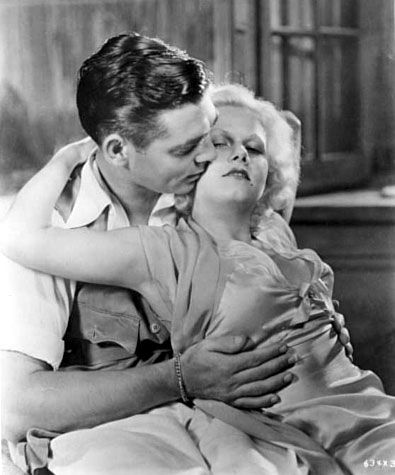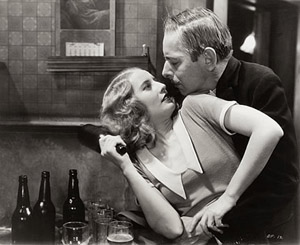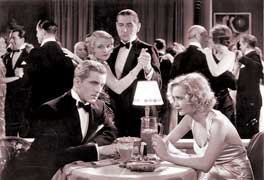 (If you’re looking for my preamble, and recommendations for the silent era, click here.)
(If you’re looking for my preamble, and recommendations for the silent era, click here.)
When your grandparents used to complain about Hollywood "not makin’ ’em like they used to", they really meant "not makin’ ’em like they were forced to make ’em as a result of the Production Code" – or "The Hays Code". Though named for the Indiana Republican politician Will Hays (then the head of the Motion Picture Producers and Distributors of America, or, awkwardly, the MPPDA), the Production Code was actually drafted by Father Daniel Lord, a Jesuit priest who, with assistance from a small group of Catholic laymen, sought to reform the amorality of motion pictures – and Hollywood in general – whilst avoiding federal censorship. The Code was chiefly a reaction to a) the Fatty Arbuckle rape/murder trial and b) the advent of sound, which Lord and others believed could, when paired with particularly intoxicating imagery, wield a massively corruptive influence over the young and impressionable. "Correct standards," declared Lord, "raises the whole standard of a nation. Wrong entertainment lowers the whole living conditions and moral ideals of a race."
Hays and the MPPDA immediately adopted Lord’s proscriptive document upon receiving it in 1930, but the studios were slow to obey it; ergo, for four years Hollywood’s creatives unleashed a spate of motion pictures so scandalous, the studios were ultimately forced to observe the Code to the letter (this hastened the era of thematic "smuggling", which we’ll get to later). The Code was extremely specific in what would not be tolerated in American films, and I’d highly recommend that you peruse the entire document (bear-baiting: frowned upon); however, in the interest of brevity, let’s stick with the "General Principals":
1. No picture shall be produced that will lower the moral standards of those who see it. Hence the sympathy of the audience should never be thrown to the side of crime, wrongdoing, evil or sin.
2. Correct standards of life, subject only to the requirements of drama and entertainment, shall be presented.
3. Law, natural or human, shall not be ridiculed, nor shall sympathy be created for its violation.
Despite the best efforts of a few wily filmmakers, these mandates shaped the medium at a time when more people than ever were attending motion pictures (i.e. 1934 – 1960). Obviously, classics were made and standards were subtly skewered, but the majority of moviegoers were being inundated by a distorted, harmfully anodyne view of the world; more than the Bible, Americans’ concepts of right and wrong were instilled by Walt Disney, Frank Capra, William Wyler and so on. It’s a fascinating legacy, one that’s probably beneficial and pernicious in equal measure.
It’s interesting, then, to consider what might’ve happened had Hollywood dodged those various censorship bullets and kept on churning out movies with loose women, lecherous men and monsters who cluelessly shot-put little girls into lakes. (Frankly, I think a whole "monsters shot-putting little girls into lakes" subgenre could’ve only changed society for the better.) Would the Catholic Church and other bastions of correctness have responded by pouring more money into film production just to counter the cacophony of boozing and drugging and fucking? Literature was already pushing the boundaries of frankness thanks to James Joyce’s Ulysses, D.H. Lawrence and Henry Miller; who’s to say American film wouldn’t have mainstreamed erotic pictures and pornography by the 1950s?
Consider this while you watch the below movies, all of which are impressive for the attitudes they espouse and the standards they flout. In assembling this list, I’ve decided to elide the early sound comedies, gangster movies, musicals and Universal horror. Evidently, I’m in no rush to end this column. There will be plenty of time to celebrate Ernst Lubitsch, The Marx Brothers, Busby Berkeley and all our favorite classic monsters. I almost snuck Island of Lost Souls on there (it’s not technically Universal horror), but let’s save that for a genre appreciation. That said, there is a full-on adventure flick to offset all of the histrionic, femme-heavy drama.
So let’s get naughty! In no particular order! (Also, I’d like to point out that there are still many pre-code movies I haven’t seen, so please feel free to suggest away on the message board. But try to avoid the aforementioned genres. Let’s stick with drama.)
 1. Baby Face (1933, d. Alfred E. Green) – What’s the secret of Lily Powers’s success? Fuckin’, that’s what! Starring Barbara Stanwyck as the wicked young woman who uses her mind and body to get all the way… well, close enough to the top to marry an extremely rich dupe, Baby Face may be the quintessential pre-code classic. It was initially rejected by the New York State Censorship Board (too much Nietzsche!), but the cleaned-up version is still plenty scandalous: though it meant nothing at the time, it’s incredibly shocking to watch Stanwyck use and abuse a young, meek John Wayne early in the film. The sexual politics of the movie are pretty screwed up, but Green and his writers – Gene Markey and Kathryn Scola, working from a story by Darryl F. Zanuck – give the men a pretty thorough thrashing, too. The original cut of the movie was recently discovered and is available as part of TCM’s "Forbidden Hollywood Collection, Vol. 1" – which you should absolutely own because it also includes James Whale’s terrific Waterloo Bridge.
1. Baby Face (1933, d. Alfred E. Green) – What’s the secret of Lily Powers’s success? Fuckin’, that’s what! Starring Barbara Stanwyck as the wicked young woman who uses her mind and body to get all the way… well, close enough to the top to marry an extremely rich dupe, Baby Face may be the quintessential pre-code classic. It was initially rejected by the New York State Censorship Board (too much Nietzsche!), but the cleaned-up version is still plenty scandalous: though it meant nothing at the time, it’s incredibly shocking to watch Stanwyck use and abuse a young, meek John Wayne early in the film. The sexual politics of the movie are pretty screwed up, but Green and his writers – Gene Markey and Kathryn Scola, working from a story by Darryl F. Zanuck – give the men a pretty thorough thrashing, too. The original cut of the movie was recently discovered and is available as part of TCM’s "Forbidden Hollywood Collection, Vol. 1" – which you should absolutely own because it also includes James Whale’s terrific Waterloo Bridge.
2. Blonde Venus (1932, d. Josef von Sternberg) – This is hardly the best of Sternberg’s Dietrich vehicles (that honor would go to either Shanghai Express or Dishonored), nor is it the most significant (take your pick: Morocco or The Blue Angel), but how can you argue with the lovely Marlene performing "Hot Voodoo" whilst shedding an ape suit? This unabashed melodrama finds Dietrich turning into a nightclub chanteuse to fund her husband’s recovery from radiation poisoning, falling for a wealthy playboy, losing her son as a result, and so on to a dramatically heightened degree. Herbert Marshall and Cary Grant (in an early, undistinguished performance) complete the love triangle. Be warned: I have an unhealthy predilection for melodrama; you might want to try Shanghai Express instead.
3. She Done Him Wrong (1933, d. Lowell Sherman) – It’s hard to believe, but Mae West has been marginalized by the unsentimental forward march of history. It’s not like we didn’t see this coming. In my youth, she was nothing more than a vague caricature parodied via Looney Tunes and The Little Rascals; the closest I got to appreciating her appeal was Spanky blurting "I’ll come up and see ya some time" to a motorist trapped atop a mountainous twelve-car pileup. This was remedied in 2001 when I finally saw my first vintage Mae West movie (neither My Little Chickadee nor Sextette present Ms. West at her formidable peak). I chose wisely; She Done Him Wrong is the Mae West movie. Adapted from her self-written stage play Diamond Lil, this is the one that features most of her trademark come-ons and a scintillating, hardly decent rendition of "I Wonder Where My Easy Rider’s Gone". Cary Grant is in this, too, and he’s much more at ease than he was with Dietrich.
4. Private Lives (1931, d. Sidney Franklin) – This is no comedy classic, but Norma Shearer is sensational as Amanda, who jilts her new husband for the old, more interesting one (Robert Montgomery) right in the middle of their honeymoon. Noel Coward would be done more entertainingly on film two years later in Design for Living (and to perfection by David Lean in Brief Encounter), but this uncelebrated, little-seen gem is still sophisticated and witty enough to rate, at least, a quality DVD release. Some of the more potentially offensive dialogue from Coward’s brilliant play has been softened, but the film is still a liberatingly irreverent swipe at holy matrimony.
5. Three on a Match (1932, d. Mervyn LeRoy) – I love this movie. Three childhood friends are reunited only to be plunged into underworld intrigue when one of them runs off with another’s gangster paramour. This stock-sounding, male-bonding setup is a must-see because the friends in question are Ann Dvorak, Joan Blondell and Bette Davis. I saw this during a pre-code festival at the Film Forum in 2001 and have been trumpeting its merits ever since. There’s intimated drug use, lots of sex and a nice turn from a young-ish Humphrey Bogart as a thug (though not the thug). I thought this finally became available on DVD, but, alas, it’s still unavailable. This is a deeply cynical, one-of-a-kind movie, and quite possibly my favorite pre-code flick; trust me, it’s worth tracking down an old VHS copy.
 6. Two Kinds of Women (1932, d. William C. de Mille) – All of the movies recommended for "further viewing" below are light years better than this conventional good-girl-goes-bad-in-the-big-city drama, but because the girl is Miriam Hopkins, it demands your attention. These kinds of stories are pre-code boilerplate, but Cecil B.’s big brother carries this off with a number of elegant visual flourishes. Phillips Holmes plays the married fella Hopkins takes up with, and he’s awful. But Hopkins is so good that you don’t mind. Many of these pre-code movies are all about watching great actresses play very bad women opposite meek men. The Production Code swung the balance back in favor of the guys; it was positively hell on the ladies.
6. Two Kinds of Women (1932, d. William C. de Mille) – All of the movies recommended for "further viewing" below are light years better than this conventional good-girl-goes-bad-in-the-big-city drama, but because the girl is Miriam Hopkins, it demands your attention. These kinds of stories are pre-code boilerplate, but Cecil B.’s big brother carries this off with a number of elegant visual flourishes. Phillips Holmes plays the married fella Hopkins takes up with, and he’s awful. But Hopkins is so good that you don’t mind. Many of these pre-code movies are all about watching great actresses play very bad women opposite meek men. The Production Code swung the balance back in favor of the guys; it was positively hell on the ladies.
7. Call Her Savage (1932, d. John Francis Dillon) – Clara Bow’s penultimate film is a seriously kinky corker about a landowner’s daughter WHO CANNOT BE TAMED!!! This is another perverse, early 30s classic that is inexplicably unavailable on DVD, but it’s a fixture at pre-code fests. They say sound ruined Bow, but this movie suggests otherwise. She’s a revelation as "Dynamite" – sleeping around, wielding a whip as a sexual aid, scrapping with Thelma Todd… this is a cult classic that should’ve happened by now. Further explaining its bizarreness would be wrong.
8. Bad Girl (1931, d. Frank Borzage) – Borzage won the first Best Director Oscar for this powerfully romantic drama about a couple fighting to survive the Great Depression. There’s nothing terribly objectionable about its content, but it is an important work for the criminally forgotten Borzage, who dramatized everything on a uniquely heightened emotional plane. The only thing insincere about this movie is the title, which is a holdover from the Vina Delmar novel on which it is (apparently loosely) based. Call Her Savage, this is not.
9. The Mask of Fu Manchu (1932, d. Charles Brabin) – A team of archaeologists are on a quest to unearth an ancient relic before a fiendish villain can find it first, harness its power and rule the world. You think Steven Spielberg and George Lucas were aware of this horror/adventure flick? Clearly one of many inspirations for Raiders of the Lost Ark, the big surprise is that Brabin’s movie still works wonderfully on its own terms. Boris Karloff plays the evil Chinese genius with no shortage of cultural insensitivity, but, um… you’ll love it if you’re not Chinese?
10. Red Dust (1932, d. Victor Fleming, Howard Hawks) – I was going to recommend Raoul Walsh’s The Yellow Ticket here, but this overheated, oversexed Victor Fleming picture is much more fun (if equally unavailable – sorry, but that’s the problem with these great pre-code titles). Clark Gable plays a rubber plantation owner in Indochina who’s content to bed down with Jean Harlow, a prostitute on the run from the law, until the married Mary Astor comes along. The eroticism on display in this flick shames the oeuvre of Zalman King. This should be available on DVD soon, but you won’t regret shelling out eight bucks for a decent VHS copy.
Further Viewing: Morocco (1930, d. von Sternberg), Dishonored (1931, d. von Sternberg), Shanghai Express (1932 d. von Sternberg), Man’s Castle (1933, d. Borzage), Girls About Town (1931, d. George Cukor), Waterloo Bridge (1931, d. James Whale), The Yellow Ticket (1931, d. Raoul Walsh)